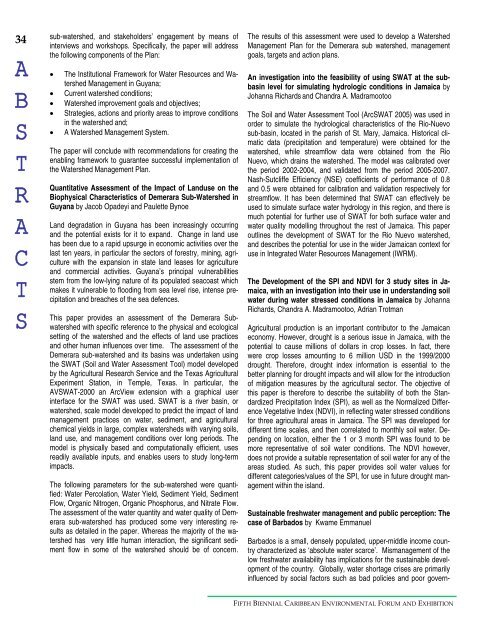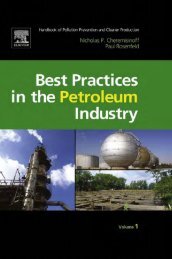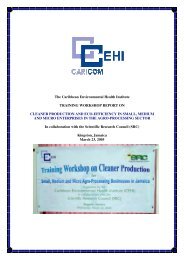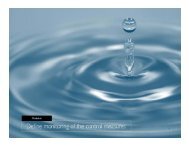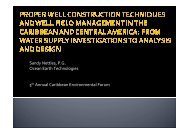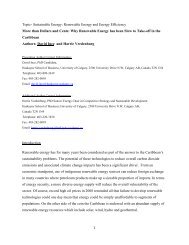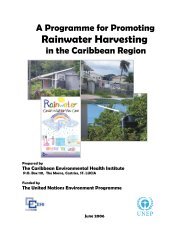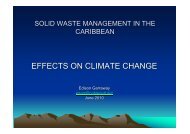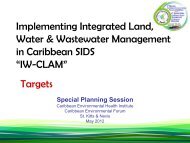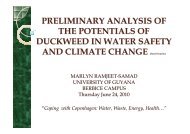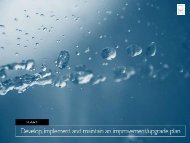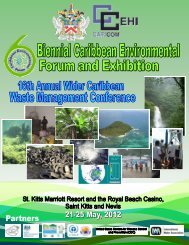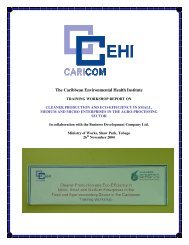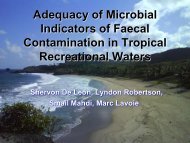conference magazine - Caribbean Environmental Health Institute
conference magazine - Caribbean Environmental Health Institute
conference magazine - Caribbean Environmental Health Institute
You also want an ePaper? Increase the reach of your titles
YUMPU automatically turns print PDFs into web optimized ePapers that Google loves.
34<br />
sub-watershed, and stakeholders’ engagement by means of<br />
interviews and workshops. Specifically, the paper will address<br />
the following components of the Plan:<br />
A<br />
B<br />
S<br />
T<br />
R<br />
A<br />
C<br />
T<br />
S<br />
• The Institutional Framework for Water Resources and Watershed<br />
Management in Guyana;<br />
• Current watershed conditions;<br />
• Watershed improvement goals and objectives;<br />
• Strategies, actions and priority areas to improve conditions<br />
in the watershed and;<br />
• A Watershed Management System.<br />
The paper will conclude with recommendations for creating the<br />
enabling framework to guarantee successful implementation of<br />
the Watershed Management Plan.<br />
Quantitative Assessment of the Impact of Landuse on the<br />
Biophysical Characteristics of Demerara Sub-Watershed in<br />
Guyana by Jacob Opadeyi and Paulette Bynoe<br />
Land degradation in Guyana has been increasingly occurring<br />
and the potential exists for it to expand. Change in land use<br />
has been due to a rapid upsurge in economic activities over the<br />
last ten years, in particular the sectors of forestry, mining, agriculture<br />
with the expansion in state land leases for agriculture<br />
and commercial activities. Guyana’s principal vulnerabilities<br />
stem from the low-lying nature of its populated seacoast which<br />
makes it vulnerable to flooding from sea level rise, intense precipitation<br />
and breaches of the sea defences.<br />
This paper provides an assessment of the Demerara Subwatershed<br />
with specific reference to the physical and ecological<br />
setting of the watershed and the effects of land use practices<br />
and other human influences over time. The assessment of the<br />
Demerara sub-watershed and its basins was undertaken using<br />
the SWAT (Soil and Water Assessment Tool) model developed<br />
by the Agricultural Research Service and the Texas Agricultural<br />
Experiment Station, in Temple, Texas. In particular, the<br />
AVSWAT-2000 an ArcView extension with a graphical user<br />
interface for the SWAT was used. SWAT is a river basin, or<br />
watershed, scale model developed to predict the impact of land<br />
management practices on water, sediment, and agricultural<br />
chemical yields in large, complex watersheds with varying soils,<br />
land use, and management conditions over long periods. The<br />
model is physically based and computationally efficient, uses<br />
readily available inputs, and enables users to study long-term<br />
impacts.<br />
The following parameters for the sub-watershed were quantified:<br />
Water Percolation, Water Yield, Sediment Yield, Sediment<br />
Flow, Organic Nitrogen, Organic Phosphorus, and Nitrate Flow.<br />
The assessment of the water quantity and water quality of Demerara<br />
sub-watershed has produced some very interesting results<br />
as detailed in the paper. Whereas the majority of the watershed<br />
has very little human interaction, the significant sediment<br />
flow in some of the watershed should be of concern.<br />
The results of this assessment were used to develop a Watershed<br />
Management Plan for the Demerara sub watershed, management<br />
goals, targets and action plans.<br />
An investigation into the feasibility of using SWAT at the subbasin<br />
level for simulating hydrologic conditions in Jamaica by<br />
Johanna Richards and Chandra A. Madramootoo<br />
The Soil and Water Assessment Tool (ArcSWAT 2005) was used in<br />
order to simulate the hydrological characteristics of the Rio-Nuevo<br />
sub-basin, located in the parish of St. Mary, Jamaica. Historical climatic<br />
data (precipitation and temperature) were obtained for the<br />
watershed, while streamflow data were obtained from the Rio<br />
Nuevo, which drains the watershed. The model was calibrated over<br />
the period 2002-2004, and validated from the period 2005-2007.<br />
Nash-Sutcliffe Efficiency (NSE) coefficients of performance of 0.8<br />
and 0.5 were obtained for calibration and validation respectively for<br />
streamflow. It has been determined that SWAT can effectively be<br />
used to simulate surface water hydrology in this region, and there is<br />
much potential for further use of SWAT for both surface water and<br />
water quality modelling throughout the rest of Jamaica. This paper<br />
outlines the development of SWAT for the Rio Nuevo watershed,<br />
and describes the potential for use in the wider Jamaican context for<br />
use in Integrated Water Resources Management (IWRM).<br />
The Development of the SPI and NDVI for 3 study sites in Jamaica,<br />
with an investigation into their use in understanding soil<br />
water during water stressed conditions in Jamaica by Johanna<br />
Richards, Chandra A. Madramootoo, Adrian Trotman<br />
Agricultural production is an important contributor to the Jamaican<br />
economy. However, drought is a serious issue in Jamaica, with the<br />
potential to cause millions of dollars in crop losses. In fact, there<br />
were crop losses amounting to 6 million USD in the 1999/2000<br />
drought. Therefore, drought index information is essential to the<br />
better planning for drought impacts and will allow for the introduction<br />
of mitigation measures by the agricultural sector. The objective of<br />
this paper is therefore to describe the suitability of both the Standardized<br />
Precipitation Index (SPI), as well as the Normalized Difference<br />
Vegetative Index (NDVI), in reflecting water stressed conditions<br />
for three agricultural areas in Jamaica. The SPI was developed for<br />
different time scales, and then correlated to monthly soil water. Depending<br />
on location, either the 1 or 3 month SPI was found to be<br />
more representative of soil water conditions. The NDVI however,<br />
does not provide a suitable representation of soil water for any of the<br />
areas studied. As such, this paper provides soil water values for<br />
different categories/values of the SPI, for use in future drought management<br />
within the island.<br />
Sustainable freshwater management and public perception: The<br />
case of Barbados by Kwame Emmanuel<br />
Barbados is a small, densely populated, upper-middle income country<br />
characterized as ‘absolute water scarce’. Mismanagement of the<br />
low freshwater availability has implications for the sustainable development<br />
of the country. Globally, water shortage crises are primarily<br />
influenced by social factors such as bad policies and poor govern-<br />
FIFTH BIENNIAL CARIBBEAN ENVIRONMENTAL FORUM AND EXHIBITION


